The Microsoft Surface Laptop 2 Review: Surface Essentials
by Brett Howse on March 28, 2019 8:00 AM EST- Posted in
- Laptops
- Microsoft
- Surface
- Surface Laptop
- KBL-R
- Surface Laptop 2
System Performance
Due to Microsoft’s longer support windows, the original Surface Laptop’s dual-core Kaby Lake-U series processors were quickly surpassed when Intel updated to Kaby Lake Refresh, which offers twice the cores and twice the threads. The Surface Laptop 2 was announced in October 2018, and Microsoft solved the problem with a spec bump to KBL-R on both the Core i5 and Core i7 models.
The Core i5-8250U is a four-core, eight-thread CPU with a 1.6-3.4 GHz frequency range. There’s 6 MB of SmartCache, and a nominal 15-Watt TDP. The Core i7-8650U offers the same cores and threads, but bumps the cache up to 8 MB and CPU frequency to 1.9-4.2 GHz, which is a significant jump from the i5. The downside of Microsoft’s release cadence though is that Intel has since released their Whiskey Lake U series processors, which aren’t available in the Surface lineup yet, and Microsoft tends to refresh in October, but not always, so there’s no timeline for when they will be added.
The extra cores are nice, but Microsoft dropping the 4 GB model from the lineup is nicer, since 4 GB is really the low-end for RAM in a non-upgradable device. Offering just 8 or 16 GB of LPDDR3 is the correct choice, so it’s great to see that as the only two options on this model.
To test the performance of the Surface Laptop 2, the laptop was set to Best Performance and run through our standard laptop suite of tests. Comparisons are against other similar Ultrabooks. If you’d like to see how the Surface Laptop 2 compares to any other device we’ve tested, please check out our online Bench.
PCMark
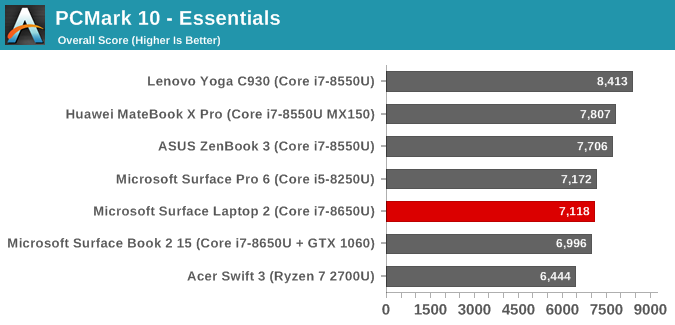
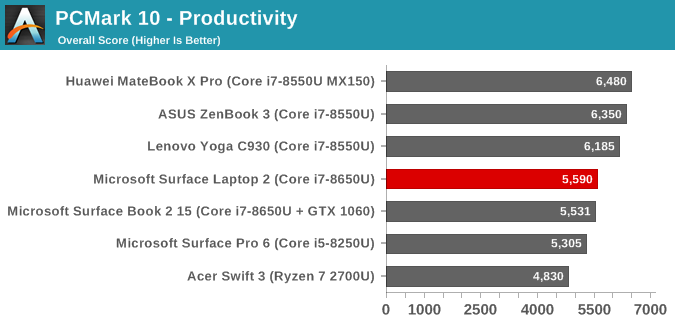
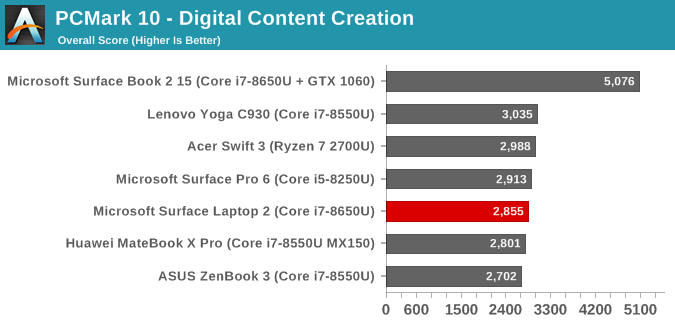
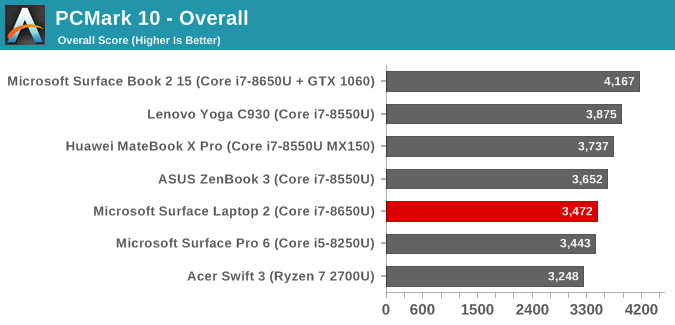
PCMark tests all aspects of a system’s performance level, from graphics to storage. The Surface Laptop 2 is mid-pack with the Core i7-8650U inside. The integrated GPU holds it back in the digital content creation score a bit, but overall it does about what you’d expect from an Ultrabook.
Cinebench
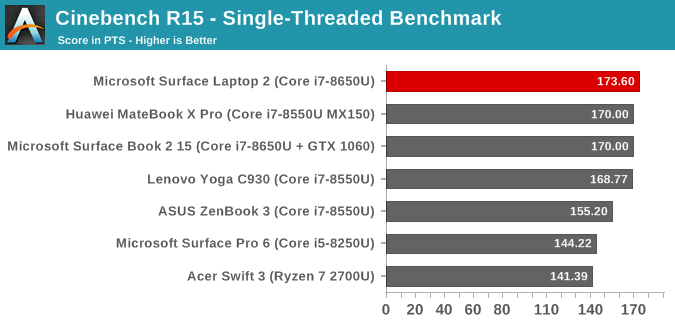
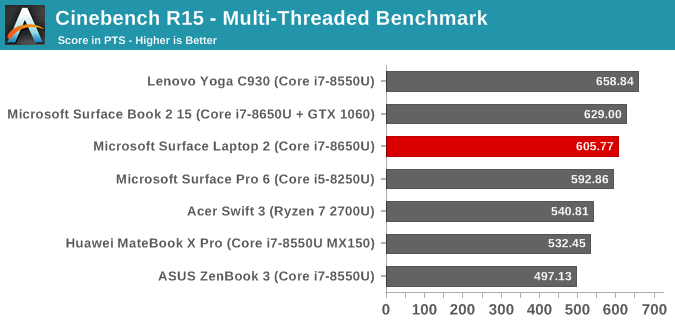
We’ve just got word that Maxon has updated this tried and true benchmark to R20 so we’ll be slowly moving to that updated version in the near future, but since we have back-data from the previous version that’s what we’re using today. The Core i7-8650U tops out at 4.2 GHz which helps a lot in the single-threaded result, and the Surface Laptop 2 holds its own in the multi-threaded test as well, although the Lenovo Yoga C930 is well ahead thanks to Lenovo offering a higher PL2 than we’ve seen on any other laptop.
x264
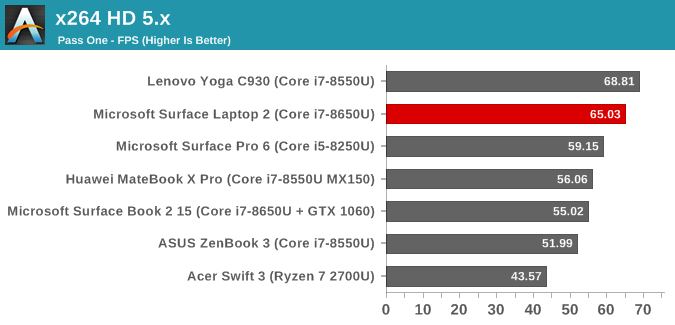
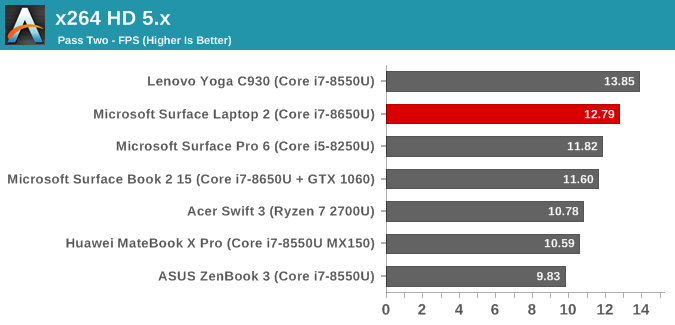
The x264 test is a very long benchmark running four times in a row and can easily take an hour to complete. As such it’s a great test to see CPU performance on a heavy load which will max out the cooling. Microsoft’s Surface Laptop 2 performs quite well here.
Web Results
Browser performance is a major factor in any web-based scripting, and we can see performance scores on the same device change dramatically over time as browsers are updated. Usually the performance trend is upwards, but not always. We standardize on Microsoft Edge for browsing tests.
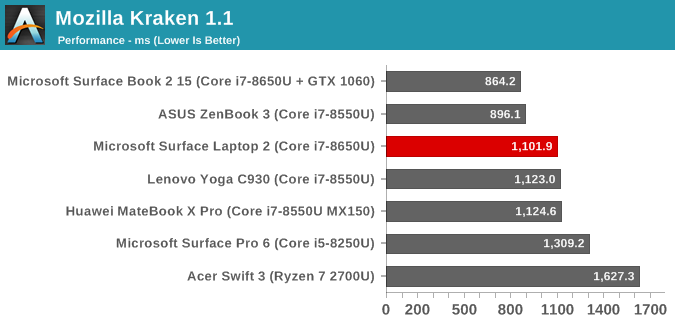

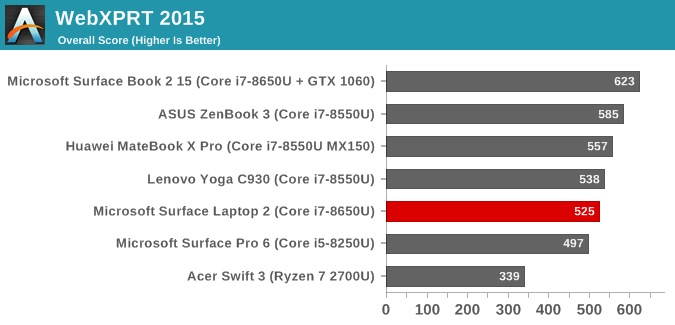
This is one area where Intel tends to hold a lead over AMD thanks to Intel’s work on Speed Shift, which lets the CPU ramp up to maximum much quicker, and that’s important in web results because web workloads are so short. The Surface Laptop 2 with its Core i7 is more or less in-line with the rest of the Core i7 models, where you’d expect it to be.
CPU Conclusion
The Surface Laptop 2 will offer significantly more performance than the original, thanks to the move to quad-core Kaby Lake Refresh. As you can see from the above results though, there’s not a lot of performance difference between the devices which tend to share a common platform underneath. Manufactures just need to make sure they offer enough cooling, and the Core i7 does the rest.











59 Comments
View All Comments
damianrobertjones - Saturday, March 30, 2019 - link
Buys a usb to usb c cable for a few pounds. Connects his phone and gopro. Carries on with life.Chrispy_ - Friday, March 29, 2019 - link
These are still utterly unserviceable, utterly impossible to upgrade, and have the terrible combination of very high price and one of the worst and shortest warranties legally permitted.Watch a video of someone trying to repair one and then ask yourself why you'd support idiocy like that, at your own cost - Ifixit teardown of the Surface Laptop 2:
https://www.youtube.com/watch?v=eShF-PFQfAk
mrboonmee - Friday, March 29, 2019 - link
how would you plug into 4K TV? DisplayPort isn't always perfect for this and not even DisplayPort? Lame. What are good alternatives?dickeywang - Friday, March 29, 2019 - link
So basically, when in comparing with the matebook x pro, the surface notebook has a weaker GPU, lacking of thunderbolt port (for eGPU)/type-c USB, a worse display but costs $700 more?LOL
PS, Huawei custom service is also better(at least in mainland China), e.g. you can buy a SSD with larger capacity and ask the custom service to replace it with the smaller one.
peconi - Saturday, March 30, 2019 - link
And still no thunderbolt. Why?VictorBd - Saturday, March 30, 2019 - link
Love my Surface Laptop 2. It’s elegant, light, snappy, and it just works. Love the keyboard and Surface Connect and dock. Easily drives 32” 4K 60hz external displays at home & office, while also perfect on the go. I also prefer USB-A and the fabric deck. Tried Asus, Samsung, Dell XPS, HP - nothing else provided me an all around balanced, light, reliable, package. And I get amazing first party service from the Microsoft store. Glad this is in my inventory.InvidiousIgnoramus - Sunday, March 31, 2019 - link
The only laptop that is literally impossible to repair.ballsystemlord - Sunday, March 31, 2019 - link
Only 1 typo, keep it up!"A few players, such as Huawei, have skirted the issue by adding a NVIDIA GeForce MX class GPU, but the added cost and complexity of that is not something that many manufacturers have gone."
Should be "done" not "gone" at the end of the sentence.
"A few players, such as Huawei, have skirted the issue by adding a NVIDIA GeForce MX class GPU, but the added cost and complexity of that is not something that many manufacturers have done."
amosbatto - Friday, April 5, 2019 - link
It is very irresponsible for Anandtech to do a long review of a product like this and not mention that it is literally impossible to repair without destroying the device. ifixit gave the previous version of this laptop a repairability rating of 0 out of 10.https://www.ifixit.com/Teardown/Microsoft+Surface+...
A lot of people are going to buy this laptop and discover in a year or two that they are screwed when something fails. A key on the keyboard stops working, and you have to throw away the entire laptop because the keyboard can't be replaced. The motherboard dies and it is impossible to get your data off the machine, because the SSD is soldered to the motherboard. The battery will start to degrade after 500 full charge and discharge cycles, so you have to throw away the machine after a couple years of use or accept that you can only use it for an hour or two without being plugged in.
Every Anandtech review should mention the fixability of a device in its reviews, because that dramatically changes the longevity of a device. A laptop which costs $500 but lasts 2 years is more expensive per year than a laptop which costs $700 but lasts 4 years. Anandtech should be an advocate for consumers, not the advocate for the planned obsolescence being pushed by the hardware industry. At the very least Anandtech should forewarn consumers so that they know that they are getting planned obsolescence when they buy a Surface laptop.